
Guests
- Hideko Tamura Snidersurvivor of the atomic bombing of Hiroshima, retired psychiatric social worker and founder of One Sunny Day Initiatives, a peace education organization.
On the 75th anniversary of when the United States dropped the world’s first atomic bomb on the Japanese city of Hiroshima, killing some 140,000 people, we speak with Hideko Tamura Snider, who was 10 years old when she survived the attack. “The shaking was so huge,” she recalls. “I remember the sensation, the color and the smell like yesterday.” Tamura Snider describes her harrowing journey through a shattered city, suffering radiation sickness following the attack, and her message to President Trump.
Transcript
AMY GOODMAN: Seventy-five years ago today at 8:15 in the morning, the U.S. dropped the world’s first atomic bomb on the Japanese city of Hiroshima. Destruction from the bomb was massive. Shock waves, radiation and heat rays took the lives of some 140,000 people, ultimately. Three days later, the U.S. dropped a second atomic bomb on Nagasaki, killing another 74,000 people. President Harry Truman announced the attack on Hiroshima in a nationally televised address, August 6, 1945.
PRESIDENT HARRY TRUMAN: A short time ago, an American airplane dropped one bomb on Hiroshima and destroyed its usefulness to the enemy. That bomb has more power than 20,000 tons of TNT.
AMY GOODMAN: Today, 75 years later, at 8:15 this morning, a temple bell tolled in Hiroshima to commemorate the world’s first nuclear attack. Tens of thousands normally gather to commemorate the bombing anniversary, but this year’s ceremony at Hiroshima’s Peace Memorial Park was kept small due to the coronavirus pandemic. Hiroshima Mayor Kazumi Matsui addressed a group of survivors and public officials.
MAYOR KAZUMI MATSUI: [translated] On August 6, 1945, a single atomic bomb destroyed Hiroshima. Rumor at the time had it that nothing will grow here for 75 years. And yet, Hiroshima recovered, becoming a symbol of peace, with many people from all over the world visiting the city.
AMY GOODMAN: For more, we’re joined by a survivor of the atomic bombing of Hiroshima, Hideko Tamura Snider. She was 10 years old when the bomb was dropped. Her memoir recounting the moment is titled One Sunny Day: A Child’s Memories of Hiroshima. She’s a retired psychiatric social worker, founder of One Sunny Day Initiatives, a peace education organization. She’s joining us from Medford, Oregon.
We welcome you to Democracy Now! It’s an honor to have you with us, Hideko Tamura Snider. Can you go back 75 years ago, 8:15 in the morning, in your city of Hiroshima? Tell us where you were and what happened next.
HIDEKO TAMURA SNIDER: Thank you, Amy, for inviting me.
Yes, I remember, even though over 75 years, just like yesterday. I was the happiest child, just home from country haven from night before, thinking so fortunate to be home. The morning was very sunny. Birds were chirping, butterflies over flowers. And I was leaning over in my own house with my back to the garden, reading a book.
First, at 7:30, was a warning siren, but the radio I turned on said the planes, three planes, came and turned around and went away. “It’s safe now. Go back to work. It was safe now. Go back to work.” So, we could resume our daily affairs.
And suddenly there was a flash in my peripheral vision. I jumped on my feet and turned around. And simultaneously, practically, with the flash came a humongous, deafening sound — so huge, I had never, ever heard — and went on, just resounding with a huge sound.
And luckily, my mother had taught me what to do if something akin to a bomb hitting our house or garden directly, to try to find very sturdy furniture and place myself between, which I did. She said, likely, even if the house collapsed on top of us, there will be a small room left. And tried to hang on, but I couldn’t even squat. The shaking was so huge, in whichever way, and thermal wind from the explosion was so violent, everything was hitting me, even if I was between two sturdy furniture.
So, I was under the wreckage. I think it was pitch dark. I could not see anything. And I think the sound of it — I did not pass out. I wish that I did. So I remember the sensation, the color and the smell like yesterday. I think it went on, in the pitch dark, almost 10 or 15 minutes. And when the sound subsided, I found myself under the debris. The house was well built with large pillars, so the roof did not come down flat on top of me. But I was not able to get out. And there was an effort, try to move towards where there was a light coming, and somehow crawl to get from under the debris.
And I was sure that it was one bomb hit our yard. But when we came out — it was a household, the family of the Tamura Industry. My grandfather, who had passed away by that time, was the chair of a multinational corporation, and Tamura Industry name, I noticed that in the map of the Allied forces, American military map had Tamura Industry clearly marked. I suppose, for all incendiary attacks and so forth, they would mark factories, you know, to aim. And so, we were one of them, and our house was fairly close to it.
When I came up outside, I found myself, huge shards of glass were stuck in my foot. And, you know, I was an only child, not given to efficient self-care. The smallest scar, I would run to my mother. You know, “Help me, mother!” — a little bruise. So I had no idea what to do. I was just terribly frightened. You couldn’t walk around with it. So, our Tamura household was filled with Tamura family extended relations. I asked an aunt, “Oh, Auntie, please help me! There’s this horrible thing on my foot!” She was not able to help me.
Everyone was scarred, bruised. And my father’s older brother, Uncle Hisao, who took over the Tamura Industry, had barely made it back to the house and was sitting and screaming to us, “It is the end! End has come!” And gashing cuts from the middle of his throat, I think he had more glass shards than everybody in the factory. The glasses, when it was destroyed, stuck all over his body, and he was bleeding from it, and bleeding all over.
It was really a very scary sight, as was when I mustered my courage — “Nobody is going to help me. I am the only one who can do” — and, with trembling hand, washed around it, after I very slowly picked this huge glass out of my leg, realizing it’s the first time I had to do something this awful and this scary, and knew, looking back on it, it was the last day of my childhood.
It’s a really long story, leaving the scene by myself, because the heat of radiation was so strong, you know, multiplied by it from the heat that will melt steel, so much more, and turned the woods on fire and turned buildings on fire. And across the street went, with a huge sound, the block full of flame, and I realized we’re going to be surrounded and burned to death if we don’t escape.
And my mother’s instruction was, “Get away from under the debris, go to the river, and save yourself. Stay by the river, and escape along the river.” And Hiroshima had several rivers — seven — from a major river coming in and pouring into the inland sea. So that’s where I headed.
In front of the gate were women on the ground, reaching out to me. And these first ladies I saw on the ground bleeding, and not even sitting, crawling, were speaking in Korean. But I could understand from the gesture.
But I was only a child. I’ve never been hurt the way I was, or seen anything like this, or the house come down. You know, a child has this feeling your parents are always going to be there, and your room is going to be there, and, you know, all your books and your world. You don’t picture it to change, even though we had been evacuated, and my mother had told me, and I know the B-29 — hundreds would go over our sky — and we were in a war. But the child, you know, can’t imagine anything changing that drastic, and people dying and bleeding and reaching, raising hands and begging, “Please help!” And there was nothing I could do. I was needing help myself.
I don’t know how much you’d like to know, because it’s a long story about fleeing that day.
NERMEEN SHAIKH: Well, Ms. Hideko Tamura Snider, thank you so much for that extremely powerful account. We wanted to know if you could say a little about what happened to your mother and to your siblings, and also the ongoing health impact of radiation, of the dropping of this nuclear bomb on Hiroshima.
HIDEKO TAMURA SNIDER: OK. I never wanted to accept it, but the last she was seen was screaming as the heavy concrete, a part of the building, falling on her. She was buried alive and burned alive at barely 30 years of age, a beautiful woman, and very loving.
I was an only child, therefore no sibling, but I had a sibling-like playmate, beloved cousin — I lived under the same — Cousin Hideyuki. The last he was seen, he was with over 8,000 children at ground zero, barely being able to walk. But a classmate of his, months after the explosion, told us he caught up with him. “Aren’t you Tamura?” Because, you know, all his clothes are burned and skin hanging, but the shape of his head, he sort of kind of recognized it must be my cousin. And he said yes. And so, the two started to walk a little bit. My cousin was barely making it. Then the plane came back, and we all thought that they came to shoot, like in the other kinds of attack.
AMY GOODMAN: Hideko Tamura, you suffered radiation sickness. Can you describe what that was like? You’re a child.
HIDEKO TAMURA SNIDER: Oh, yes, yes. I was caught up with my cousin’s story. I’m sorry. I loved him so much, that I just slow down.
I was covered with boils in August, afterwards. And then, suddenly, I started to run a very high fever, off the chart. Hair falling, stomach trouble. And I think I bordered life and death for weeks, and then finally it came down, but followed with jaundice. My white of my eyes were completely yellowed. And you could tell, even though Asian skin tends toward golden, I was totally yellow, in a sort of much yellowish hue. And I was exhausted, like liver trouble, you know, jaundiced.
I had no energy to even walk around. And I would sit where I was with my relations, where we took refuge. I was not able to go to a school. I missed most of my school days because of that. It was in a sort of like a top of the mountain type of a place, in a town called Kabe, quite a bit away from Hiroshima.
And I noticed, where I was, you know, exhausted and ailing, some of the people who had been in Hiroshima were dying, with thyroid blowing up, high fever, and then bleeding from orifices and having red spots all over. We didn’t know, you know. We were even worried about mosquito bites, if it was a start of the radiation sickness. We didn’t have that word. We didn’t know it was atom bomb-related, because only those people who barely survived, but not really. It was like you were not well. People suddenly then died. Even those who came to look for their kins entered the city, had the similar kind of reaction.
AMY GOODMAN: Hideko Tamura Snider —
HIDEKO TAMURA SNIDER: Yeah.
AMY GOODMAN: Astoundingly, you would ultimately come to the United States to go to college, Bennett College in North Carolina, and you then got training as a psychiatric social worker. You live in Portland. It’s 75 years ago today, as you have told your story to people, to students, to community groups. What message do you have for President Trump today, as many fear the beginning of a new nuclear arms race?
HIDEKO TAMURA SNIDER: Well, you know, I came to a conclusion — all survivors did — the people of Hiroshima now would like to issue message that this is a horrific bomb, so harmful and inhumane that the human race cannot live with it. And we want to get that message out to everyone.
And my way, as a former clinical social worker, is to encourage, to former enemies especially, to come closer, in what I call collective healings, because there seems to be still anger tied up about the Pacific War against Japanese. And that means they’re not healed, either. And in our attempt to heal, we have to promote: “Don’t let this happen to you. This is horrible.” I chair One Sunny Day Initiatives to do that, and I try to bring that which would encourage seeking solutions and seeking treaties and seeking collective approach to be able to live in peace in the world.
However, if you are especially pointing me to speak something to President Trump, I would say the same thing. Mr. President, this is unallowable weapon on this Earth. Please help us. Talk it out through treaties, rather than intimidating, intimidating and pushing, because throughout the history it’s not the intimidator that will start a war and do unwise things. It’s the intimidated that would study any of their chances, and if they thought there was nothing, they would strike back with everything possible. And should they have their hand in nuclear weapon, please be prepared. It is the beginning of our end.
AMY GOODMAN: Hideko Tamura Snider, I want to thank you so much for being with us, survivor of the atomic bombing of Hiroshima. The memoir recounting that moment is titled One Sunny Day: A Child’s Memories of Hiroshima. She’s a retired psychiatric social worker, founder of One Sunny Day Initiatives, peace education organization. She lives in Medford, Oregon.
When we come back, we’ll be joined by Greg Mitchell, author of many books on Hiroshima, including his latest, The Beginning or the End: How Hollywood — and America — Learned to Stop Worrying and Love the Bomb. Stay with us.

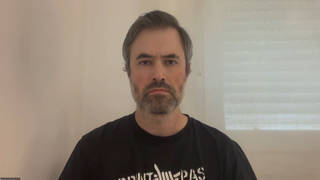
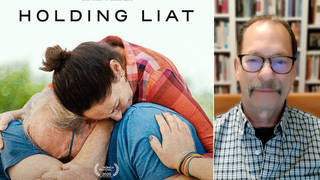
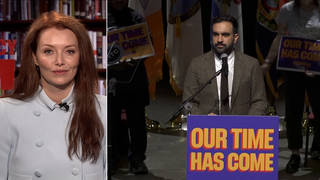
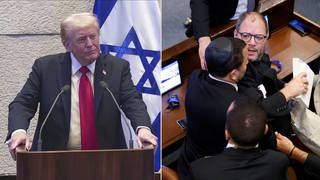



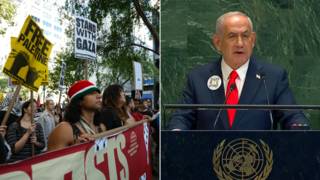

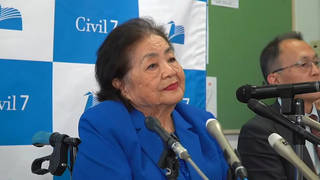
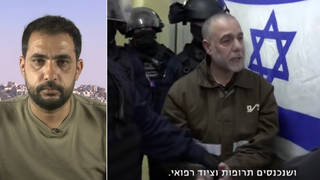
Media Options